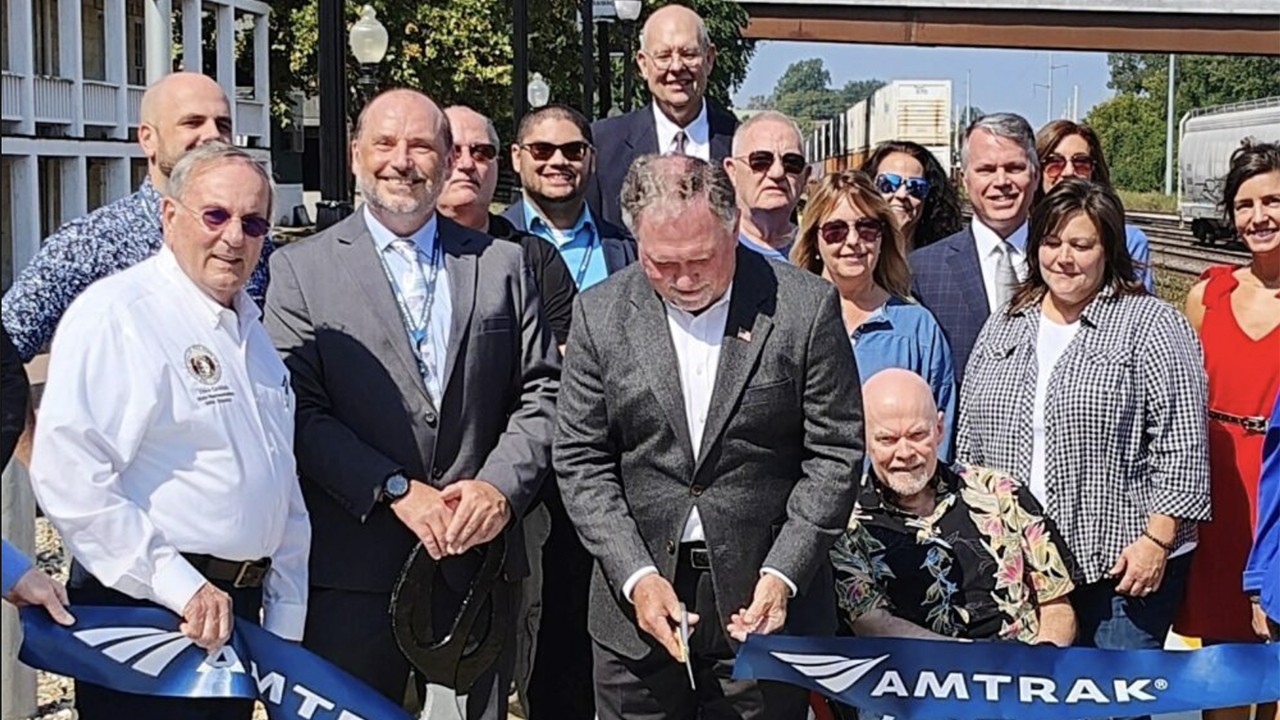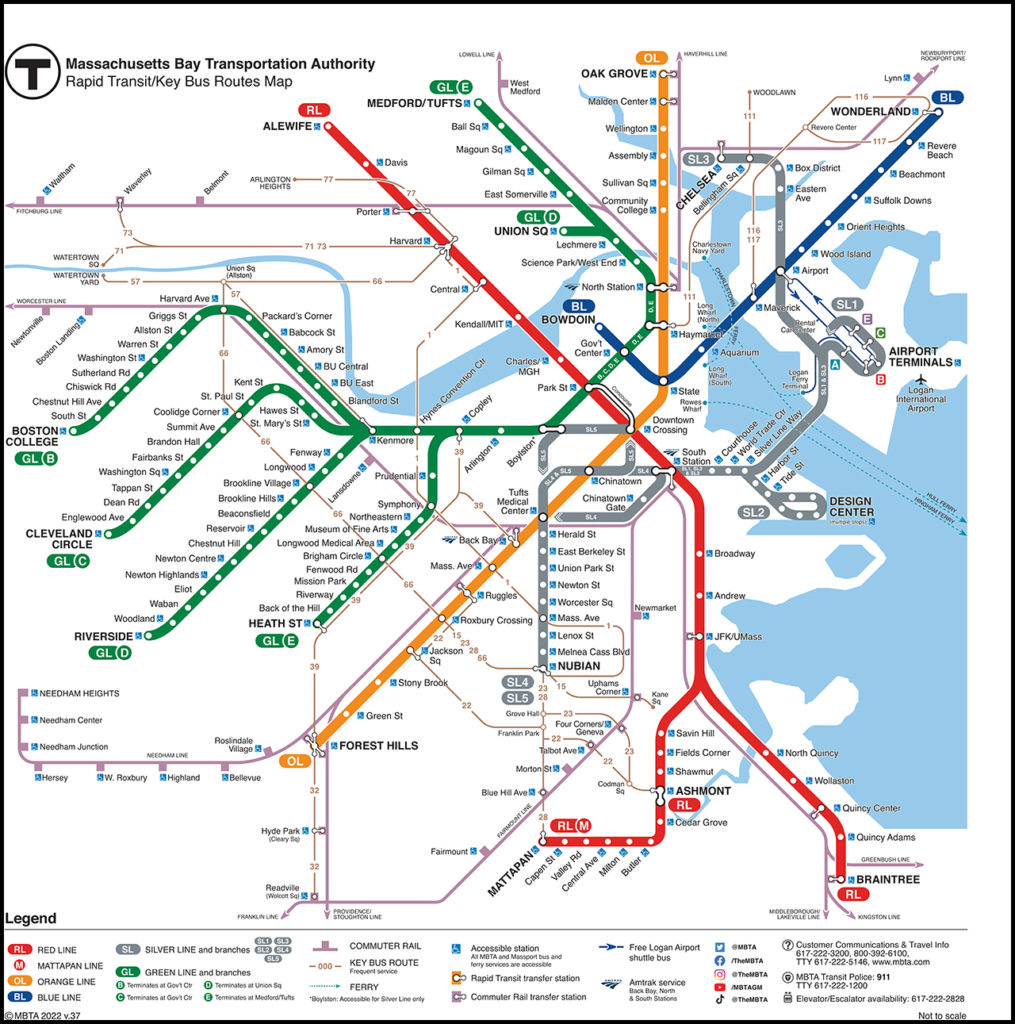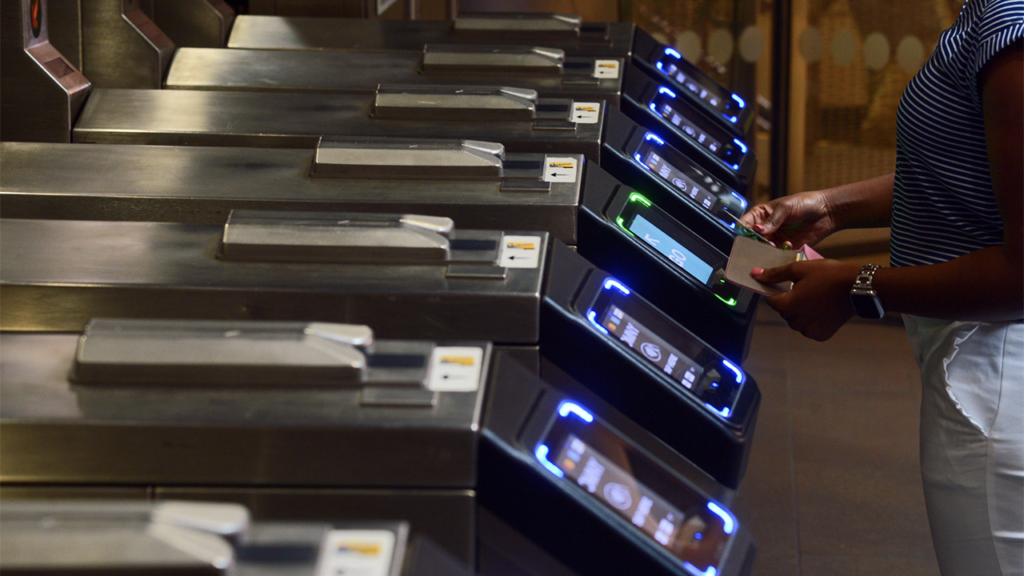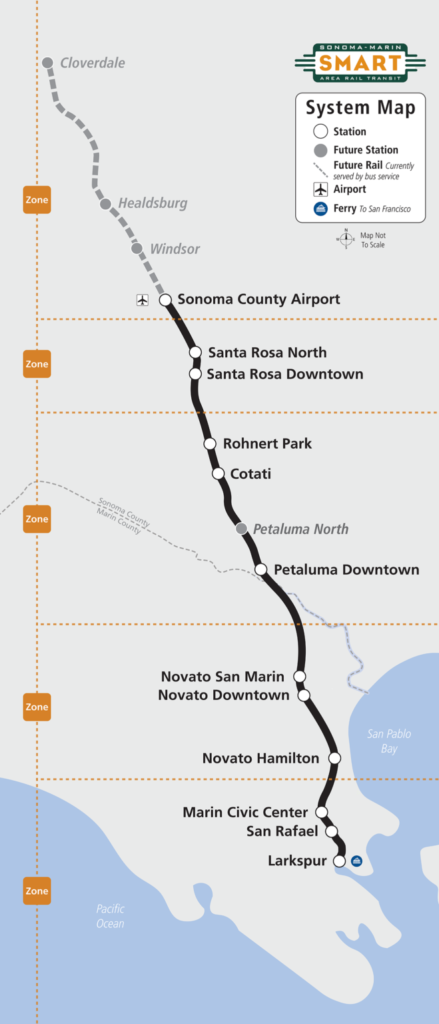
Transit Briefs: Amtrak, MBTA, NYMTA, SMART
Written by Marybeth Luczak, Executive Editor
Amtrak on Sept. 21 celebrated the $1.4 million renovation of its Missouri River Runner-served station in Jefferson City. (Amtrak Photograph)
Amtrak completes $1.4 million station-accessibility upgrade project in Jefferson City, Mo. Also, Massachusetts Bay Transportation Authority (MBTA) schedules fall service shutdowns for maintenance work; New York Metropolitan Transportation Authority (MTA) reports post-pandemic subway ridership records and releases a Request for Information for subway platform cooling technologies; and Petaluma, Calif., receives $30.2 million for affordable housing at the future Petaluma North SMART (Sonoma-Marin Area Rail Transit) Station.
Amtrak
Amtrak on Sept. 21 celebrated the $1.4 million renovation of its Missouri River Runner-served station in Jefferson City. The service, operated under contract with the Missouri Department of Transportation (MoDOT), links St. Louis and Kansas City, with stops in Jefferson City twice daily, eastbound and westbound.
Amtrak, working with the city, advanced a series of accessibility improvements in accordance with the Americans with Disabilities Act (ADA):
- Replacement of the former asphalt platform with a new 325-foot-long concrete platform, which is eight inches above top-of-rail. According to “America’s Railroad,” it provides a level surface for wheeled mobility-device users and includes a tactile detectable warning system along the full length for passengers with vision disabilities.
- Construction of a new concrete ramp and landing near Jefferson Street, which provides an accessible path of travel to the new platform, with a second ramp located at the west end of the platform.
- Installation—in consultation with the Missouri State Historic Preservation Office—of LED pole-mounted light fixtures on the platform and pathways. According to Amtrak, the fixtures not only add light and boost safety, but also are designed to complement the historic fabric of the site and style of the surrounding streetlights.
New signage and guardrails were also part of the project.
A group of volunteers staffs the station, using a temporary facility until the state-owned historic building normally used can be reopened, Amtrak reported.
“Making our stations accessible to all customers is a priority and we’re actively performing construction, renovation, repair and upgrade projects at stations across our national network,” Amtrak Vice President David Handera said. “We want Jefferson City and all of our stations to be a welcoming and comfortable environment to all of our customers.”
“We are well aware that as the Capital City, it is important that citizens be able to access state government and other facilities in our beautiful city; Amtrak is a critical piece of our transportation infrastructure,” said Jefferson City Mayor Ron Fitzwater, who spoke at the ribbon-cutting event. “We are excited for the enhancement to facilities here in Jefferson City.”
“At MoDOT, we are proud to have a partnership with Amtrak and communities across the state,” MoDOT Director Patrick McKenna said. “This route supports thousands of jobs and generates hundreds of millions of dollars in economic activity for this state.”
Amtrak reported that it has invested $793 million since 2011 in accessibility upgrades and improvement projects at 118 stations across the national network. The improvements include repairs and upgrades to platforms, ramps and sidewalks, and renovations to entranceways and restrooms, with 20 stations brought into ADA compliance last year. Another 20 stations are targeted for completion this fiscal year at a forecasted investment of $125 million.
Amtrak said its program is advancing 143 station designs and 39 station construction projects for accessibility and working toward 100% completion by 2029.
MBTA

October service changes will allow crews to continue improvement work system-wide, MBTA reported Sept. 19. The Red, Orange, Green, Mattapan, Kingston, Middleborough, Greenbush and Haverhill lines will experience changes.
Accessible shuttle bus service will replace Red Line trains between Broadway and Ashmont Stations on the Ashmont Branch and between Broadway and North Quincy Stations on the Braintree Branch on the weekends of Sept. 30-Oct. 1 and Oct. 7-8. Crews will work on the Savin Hill Avenue and Dorchester Avenue bridges, perform necessary tunnel inspections on the Ashmont Branch, and accomplish station brightening work at the JFK/UMass Station.
The Kingston, Middleborough and Greenbush Commuter Rail lines, which run adjacent to the Red Line, will also experience service changes during the same weekends. Accessible shuttle bus service will replace trains between South Station and Braintree, and accessible express shuttle bus service will also operate directly between South Station and Braintree Station.
Additionally, accessible shuttle bus service will replace Red Line Ashmont Branch and Mattapan Line trains between the JFK/UMass and Ashmont Stations and the Mattapan Station for 16 days from Oct. 14-29 for track replacement work, as the track between the JFK/UMass and Ashmont stations and on the Mattapan Line is some of the oldest in the system, MBTA said. This diversion will allow crews to replace rail, ties and ballast to improve reliability and travel times, reduce maintenance needs, and alleviate 28 speed restrictions. MBTA also said it plans to maximize these full-access closures by making station improvements such as painting, power washing and repairing lighting fixtures; vegetation and tripping-hazard removal; and accessibility upgrades.
As previously announced, MBTA said, the Massachusetts Department of Transportation will perform Squires Bridge repair work in Somerville from Sept. 18-Oct. 12. The bridge crosses over the Green Line tracks near Union Square Station. As a result, Green Line train service between the Lechmere and Union Square stations will be suspended during this time.
Also as previously announced, accessible shuttle buses will replace Haverhill Line trains between Ballardvale and North Station for 58 days from Sept. 9-Nov. 5, allowing crews to perform Automatic Train Control (ATC) work, according to MBTA.
MTA

MTA on Sept. 21 reported that the New York City Subway recorded its highest post-pandemic single-day total for paid rides on consecutive days. On Sept. 20, subways recorded 4,179,902 paid rides, surpassing the previous post-pandemic high of 4,144,828 set just a day before, on Sept. 19. According to MTA, this is the fourth time in the past two weeks that subway ridership has surpassed the 4 million mark. Additionally, there were more than 4 million paid entries into the system on Sept. 12 and Sept. 14, during the first full week of school in New York City.
The MTA commuter railroads also saw post-pandemic highs. The Long Island Rail Road (LIRR) set a post-pandemic record on Sept. 20, carrying 242,202 riders and surpassing the previous high set on June 21, 2023, the transit authority said. LIRR carried more than 200,000 riders eight straight days starting Sept. 11.
Metro-North Railroad set its post-pandemic record on Sept. 19, carrying 224,426 riders, according to MTA. This surpassed the previous total set on June 20 when Metro-North carried 224,371 riders. In addition to the overall post-pandemic high, Metro-North during the week of Sept. 17, celebrated its highest ridership on a Monday (Sept. 18) since the pandemic with 192,103 paid rides.
OMNY, the MTA’s contactless payment system, also set consecutive-day records. According to the transit authority, on Sept. 20 there were 2.32 million taps systemwide. This is the second time OMNY taps hit 2.3 million taps in a single day, the first coming a day before, on Sept. 19. Additionally, there were more than 1.93 million taps into the subway system on Sept. 19, a record that came just a day after subway taps hit the 1.9 million-mark in a single day for the first time, MTA noted. OMNY market share of paid subway rides continues to be at or above 45%, MTA said, since it updated its fare-capping schedule on Aug. 20.
Also on Sept. 21, MTA issued a Request for Information on cooling technology that can be deployed in the New York City Subway system (see above). “With extreme heat conditions on the rise and expected to increase further amid the effects of climate change in the next few decades, the MTA is seeking information on innovative ways to cool subway stations, particularly for passenger-occupied zones on platforms,” the transit authority reported.
The solicitation invites organizations to propose strategies to MTA Construction & Development (MTA C&D) for cost-effective, low-emissions station cooling solutions that align with the MTA’s commitment to cut greenhouse gas emissions by 85% by 2040, the transit authority added.
During the summer, particularly on days where temperatures reach 90 degrees or greater, subway platforms are often significantly hotter than the street level due to train braking, train air conditioning units, and limited station ventilation. According to MTA, effective strategies would provide cost-effective, localized cooling of air on subway platforms to keep platform temperatures below 85 degrees on days in which temperatures reach 95 degrees or more.
So far, cost constraints and challenging physical environments have limited station cooling in the subway system, MTA said. However, there are air cooling systems installed at 34 St.-Hudson Yards 7; Grand Central 4, 5, 6; South Ferry 1; 96 St., 86 St., 72 St. Q; Lexington Av.-63 St. Q, F; and Cortlandt St. R. Additionally, there are fans installed on the platforms at the Times Square-42 St. Shuttle; Grand Central 7, 14 St.-Union Square 4, 5, 6; Wall Street 2, 3; and Bowling Green 4, 5.
Commented MTA C&D President Jamie Torres-Springer: “This solicitation allows us to explore sustainable and innovative technologies that can be achieved feasibly within our complex stations and in conjunction with our ambitious state of good repair commitments.”
“The best way to keep riders cool in the hottest weather is frequent service that gets them quickly into fully air-conditioned trains,” added New York City Transit President Richard Davey. “Recognizing though that climate change will lead to more days with 90-degree temperatures in the 2030s, seeing if there are ways to cool platforms down, even incrementally, makes sense to improve long term customer experience and satisfaction.”
MTA reported that according to the New York City Panel on Climate Change, there will be up to three times as many days with temperatures over 90 degrees and up to nearly four times as many heat waves in the 2030s compared with recent years.
SMART

SMART, the city of Petaluma and Danco Communities earlier this month reported that their joint Meridian at Petaluma North Station project was awarded $30.2 million from the California Strategic Growth Council to create 131 affordable homes alongside a new Petaluma North SMART station, with biking and walking options for the community. The project will feature seven apartment buildings on 5.29 acres, laid out around a central community garden and open space. Site amenities will include a basketball half-court, a play field and recreational area for children ages 13-17, and a “tot-lot” for children ages 2-12.

Each unit will feature EnergyStar appliances and include a real-time energy monitoring display as a tool for residents to track their own energy use and minimize their energy bill, according to the partners, which noted that ventilation, plumbing, heating and cooling systems will all exceed EPA and California standards. The majority of units will be targeted as rentals to families earning between 20% and 60% of household AMI. Thirty-three apartments will be designated as Permanent Supportive Housing (PSH) units, which are designed for residents who have experienced homelessness in the past and offer supportive services that help residents access healthcare and find employment support.
An adjacent acre lot will be the home of the future Petaluma North SMART train station, which will expand rail transportation to Petaluma’s East Side (see map, left).
The Petaluma City Council in May signed off on an agreement between the city and SMART to build the new Petaluma North Station, the second SMART station in the city. It is expected to be completed in 2025.
“For SMART, it’s a source of pride to see our regional public transit rail service play a pivotal role in securing this vital funding award,” SMART Board Chair Eric Lucan said. “We’re thrilled to be part of the [public-private] partnership that will not only enhance climate-friendly transportation options but also bring about affordable housing and sustainable living in Petaluma.”



